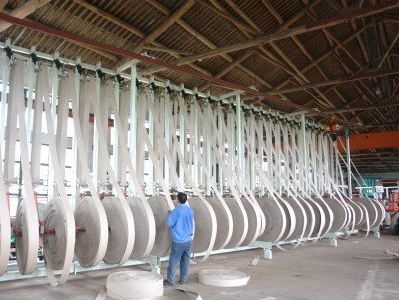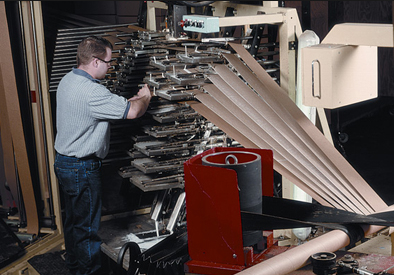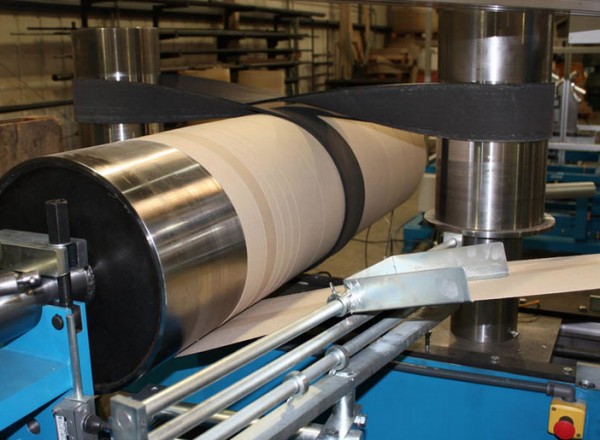
Have you ever seen the television show How It’s Made? If you find yourself wondering how things are put together, assembled, or used, you may find it interesting. The format is simple – take a few cameras into a manufacturing facility and capture each step of the process. By showing viewers the manufacturing process, questions are answered before they need to be asked.
The same is true with spiral paper tubes. The more our customers understand about how spiral paper tubes are made, the better service we can provide. Knowledge is power. The more we understand raw materials, structure, and process, the more power we each have to make well-informed packaging decisions.
Paper tube manufacturers can be found throughout six continents, and each is unique. Just like furniture manufacturers, paper tube manufacturer have special markets, niches, preferences, and machinery. Some only make toilet paper rolls, while others only make wine bottle canisters…and then there is everything in between.
The purpose of today’s blog is to help you understand the basic steps of making a paper tube.
Step 1: Rolls of Paper
As mentioned before, each company does things a little differently. Above is an image of how one manufacture chooses to “hang” their rolls of paper. The width of each roll looks to be about 6 inches. The thicker a paper tube is, the more plies (layers) of paper will be required.
Based on the number of rolls shown, the paper tube about to be made here is going to be very thick, and have a very large diameter (approximately 24″-48″). Based on the kraft brown paper, this paper tube will also be kraft brown.
Step 2: Glue the paper
Paper tubes are able to keep their form because the paper is glued together. Below is an image of one manufacturer’s gluing system. This particular system is known as a “cascading” gluing system because glue is pumped onto each ply (layer of paper), and the excess is scraped off and recycled back into the system. It is an efficient way to apply just the right amount of adhesive to the plies without wasting the excess.
This gluing system is setup to take more plies that what is shown. Seven plies of paper can be seen coming through (left to right) the gluing system and being fed into the “winder.”

Step 3: Wind the Plies
The third step in making a paper tube is winding the plies of paper around the mandrel. The machine that gathers the different plies of paper and wraps them around the mandrel (metal bar) is called the winder, so this step in the process is referred to as “winding.”
The image below shows a manufacturer making a paper tube with a diameter of approximately 12:-14″. The plies of paper are coming in from the right, going under the mandrel, and back over the top. The black tube winding belts, wrapped around the “heads”, drive the operation.
The belt pulls pulls the paper forward, towards the cutting unit, creating an endless spirally-wound paper tube.

Step 4: Cut the paper tube
The cutting unit the final step in the process. Some manufactures use saws to cut the paper tubes while others use knives. The image below shows a manufacturer using rotary knives. The paper tube is being directed into the cutting unit, and at the right time, all of the rotating knives will come in towards the paper tube and cut it to length.
The end length is determined by the distance between each knife. The knives will be spread out more for longer tubes.

After the tube is cut to length, it’s packaged and shipped. Some tubes are sent to another manufacturer while others are sent to the end user. Companies that make stickers or paper towels are an example of a manufacturer needing a paper tube, or paper core, to produce their product. A Mailing Tube is an example of a product that might be sent directly to the end user, to insert their poster and mail to their customer.
Paper Tube Supply Chain
The paper tube supply chain requires each company to produce a high quality product that can then be used by the next company or person. If a paper manufacturer produces poor quality paper, it may come apart during the paper tube manufacturing process or produce a structurally weak paper tube.
If the paper tube manufacturer does not apply enough adhesive/glue, then the paper tube may unravel, resulting in a product that cannot be used. If the cutting unit is not programmed correctly, the end result may be paper tubes with the wrong length, again, creating product that the customer may not be able to use.
Making a paper tube is a science and an art. It requires high quality raw materials, attention to detail during the manufacturing process, trained personnel, and a quality control system that ensures the end product is made according to order specifications.
Spiral Paper Tube and Core has fine-tuned both the science and art of manufacturing over our sixty-six year history. Over the years, older machines have been replaced with faster, more efficient machines, allowing us to produce more in shorter periods of time. We strive to continually produce high quality products while providing excellent, helpful customer service.


hello, i find your artical very good.
i would like to know and understand batter, how they calculate the paper tube finish product production speed?
i mean if we have 3″ (76.8 mm) diameter and lets say 8.0 mm thickness, What is the ratio of drum rotations to the angle of paper indentation and paper width to the speed of the finished product?
I find it interesting when you said that paper tube manufacturers must put enough glue to each tube to ensure that it won’t unravel and end up not being used. My brother always loved used paper tissue cores for DIY projects, so he would be interested in this article. I’ll share this to him later when we both finish online classes. Thanks for the informative article!
Hi Levi. Thanks for your comment! We hope your brother enjoys the article as well.
Hi this is Anil from India. How to determine specifications of paper core basing on weight, is there any formula to determine it.
Hi, this AAMER from KSA , i have Inquiry What are the causes and factors that lead to the bending of paper tube after output ?
Hi, this is C S Kulkarni, My query is about ply angle. Can you explain how ply angle is arrived. Is it possible to change ply angle for same width. What is good ply angle for 6″ Id cores. What is high spiral angle winding cores?
Is there any calculator to estimate flat crush of a paper core by using core board specifications like core board thickness, ring crush,etc? I am interested in such calculated hence this request.
Hi CS Kulkarni,
Thank you for your comment. Unlike corrugated boxes, paper tubes don’t have crush tests, however, there are ways to test the strength of a paper core.
Here’s a link that we think you will find helpful: http://www.packtest.com/product/paper-core-collapsing-strength-tester
Merry Christmas!
I MAY HAVE PLEASURE TO CONTACT THROUGH FACEBOOK MESSENGER REGARDING CONTACT FOR SPIRAL PAPER TUBE WINDING TRAINING THANKING YOU NARESH JOSHI
Hi Naresh,
Thanks so much for reaching out. Unfortunately, we do not use Facebook messenger. You can reach our offices at +1-562-802-9705 or email info@spiralpaper.com anytime. Thanks again.
Hello Spiral Paper Tube,
I need spiral paper tube winder operator training. Any ideas where I can get this? Thank you.
Hi Naresh,
We’d love to help. Please call us anytime at +1-562-801-9705. We look forward to hearing from you?
Hi, this is C S Kulkarni from India. In India most of the film winding cores are manufactured with 4″ ply width. In above description it seams you use 6″ ply width. Is ply width important for aspects like flat crush & bending?
Hi C S Kuhkarni,
Our use of 6″ wide plies has more to do with preference than crush strength of the paper tube. Great question!